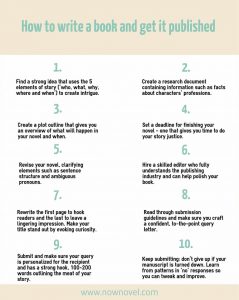Learning how to write a book and get it published is a process of many parts, so it’s wise to be systematic. Here are 10 steps to write your own bestseller and set about finding an interested publisher:
Step 1: Find a strong, marketable story idea
Choosing a strong, stand-out story idea is the first step towards publication. When you pitch a novel to publishers, your plot synopsis is the first thing people will notice (along with your credentials, the language and phrasing of your submission and the title of your manuscript).
What is a marketable story idea? It’s one that:
- Immediately creates interest by using some or all of the five w’s of story (‘what’, ‘when’, ‘why’, ‘where’ and ‘who’)
- Contains the promise of conflict and/or dramatic tension
- Fills a gap in the existing market and appeals to a defined audience
A publishable story is one that readers enter wanting to find out who the cast of the story is and how their story proceeds.
Books that have had phenomenal publishing success in recent years all contain the promise of conflict and dramatic tension in their central ideas. In J.K. Rowling’s Harry Potter, an ordinary boy finds out that he will attend a fantastical school for wizards but also learns that there is great danger facing the wizarding world. In Suzanne Collins’ The Hunger Games trilogy, children living in the dystopian country of Panem must fight to the death each year in a televised event.
Both these series have sold millions of book copies (Rowling’s fantasy series being the bestselling series of all time at over 450 million copies sold). Although fantasy books that follow the trials of a ‘chosen one’ are nothing new, Rowling made the familiar genre tropes her own.
For example, the wizards view ordinary people (or ‘muggles’ as they are called in the books’ fictional world) as strange and other, a reversal of the more common focus on how wizards are fantastical and out of the ordinary compared to ourselves.
You don’t have to reinvent the novel to fill a gap in the market. You can carve out your own niche by taking standard conventions in a genre and adding a refreshing new take of your own.
Once you have found an idea for a novel you’re happy with, It’s time to prepare to write your book:
Step 2: Prepare your own handy research document
If your story idea calls for any specialty research, do some quick preliminary research before you start drafting. Things you may need to research for your book:
- Characters’ professions
- Details about real-world settings
- Historical details such as dates and events (if writing realist fiction or historical fiction)
- How particular technology, political processes or cultural practices work (depending on your genre and subject matter)
This may seem like a lot to keep track of, but you can put together a basic research document quickly. To do so:
- Create a document and Create headings corresponding to the letters of the alphabet. This will help you find relevant information quickly while writing if you need to.
- Under ‘P’ (for example), write ‘Professions’. Here you can note down any important details about characters’ jobs and what they entail, if their professions are central to your story (as in a medical drama, for example).
- Add to your research document whenever you find any factual information that will be useful to your story.
Once you feel you have the necessary basic information you need to write, plan your writing schedule and outline your book:
Step 3: Plan distraction-free time to write and outline your book
What is distraction-free writing time? It’s time you put aside to focus completely on your writing. So many aspiring writers report not having time to write, but it’s crucial to make time to write a book.
If you don’t have a plan that will help you steer clear of writer’s block, you could get stuck. Some writers swear by pantsing, but remember the benefits of outlining a novel:
- You have a guiding roadmap for writing about a logical sequence of plot events
- You have greater freedom to shuffle narrative events around because you have a bird’s eye view for the layout of your story
- You can work on scenes from your novel out of sequence if you like, because you’ll know how to stitch it all together thanks to your outline
If you haven’t outlined a book before (or want to try another approach) learn how to write a book with Now Novel’s suite of outlining tools plus our ever-helpful critique community.
Once you have an outline you can use, it’s time to set a deadline and get going on your first draft:
Step 4: Set a manageable deadline and finish your first draft
Another advantage of creating an outline for your book is that you’ll have a better sense of how many chapters or sections it will contain. This makes it easier to choose an informed deadline. When you set a deadline for finishing your first draft in your Now Novel profile, it automatically calculates when you will finish your book by calculating how many hours you have available for writing weekly.
Choose a realistic deadline. Although NaNoWriMo success stories prove that it’s possible to write a first draft in 30 days, give your novel the time it needs to be fantastic because this will increase your chance of getting published.
When you start outlining, the size of the task in front of you might seem overwhelming. So break it down into manageable, smaller increments. Some tips for drafting a novel faster and more productively:
- At the start of every writing session, note down where the scene will be set, who it will involve, and what the narrative purpose of the scene will be (for example: ‘London; main character and a new acquaintance/love interest; scene shows the character moving closer towards her romantic/love objective but shows some of the challenges she will need to overcome’)
- Don’t stop to edit while writing a first draft – leave this for step 5, revision
- Leave some details out or fill them in using shorthand and add factual or descriptive details later if you have some momentum going
Remind yourself constantly that the first draft has one purpose – getting your story onto the page. Revisions and edits will polish a basic story into something more captivating.

Prepare to launch your book
Join a course led by multi-published authors and learn how to publish and promote your book..
Learn moreStep 5: Revise, revise, revise
Revision can be a thorny process. You might realize that the chronology of events in your novel is flawed or that characters change names or other gremlins creep into the story throughout your first draft. Revise and be ruthless about it. Janice Hardy at Janice Hardy’s Fiction University offers an excellent series of tips for revising your novel in 31 days here. Topics include ‘eliminating unnecessary told prose’ and ‘clarifying ambiguous pronouns’.
When you revise your draft, ask yourself the following questions regularly:
- Are my sentences structured and easy to follow?
- Is it clear which character is speaking or narrating?
- Do I have all the right formatting, grammar and punctuation (does a change in speaker start on a new line in dialogue, for example, and does punctuation such as commas and full stops lie inside closing speech marks)?
- How does this scene contribute to the story arc? How does it deepen or alter the reader’s understanding of a character or the story and its overarching theme and message?
Because revising your own work is challenging, it is essential to get an editor who knows how to write a book and get it published:
Step 6: Get an editor who knows how to write a book and get it published
Why do you need an editor for your novel if you want it to be published? For multiple reasons:
- An editor helps turn your rough book into the best possible version of itself, suggesting changes that will make it leaner and more compelling
- A good editor will have a good knowledge of the publishing industry and what turns major publishers on or off
- An editor will help you eliminate all significant errors from your manuscript before you submit to publishers, giving your manuscript a more polished, publishable finish
Publishing veteran Jane Friedman has some excellent advice on what not to do when hiring an editor:
Friedman advises:
- Don’t submit your work to an editor without prior contact: Write a great query letter first to establish a connection and test the waters for interest
- Don’t phone editors to query or (even worse) to chat – it’s better to make written contact
- Don’t rush the editorial process – give your book the polish your story demands and deserves
How do you find a great book editor? Friedman advises attending writing conferences where editors will be speaking. This is one good option (At Now Novel, we also have our own in-house editor who is a PhD-holding, experienced book editor).
Once you have whipped your manuscript into shape, it’s time to apply the finishing touches:
Step 7: Rewrite the first and last pages and choose a glorious title
Once you have a polished manuscript, make sure that your first and last pages are equally strong.
The first page is what will lure a new reader in, while the last leaves a lingering impression. A great title is equally important. Friedman points out that if you secure a book contract with a major publisher, you might not have much say in the final title. If you are planning to self-publish, however, you’ll have more freedom.
What makes a great book title? Some elements of a good title:
- It arouses curiosity
- It is memorable
- It relates to and suits the content of your story
- It doesn’t sound derivative of another author’s work
Think of some of the most unusual and effective book titles in publishing. The Italian author Italo Calvino’s novel If on a Winter’s Night a Traveler is a good example. The title creates curiosity by being an incomplete conditional clause (we immediately ask ‘if on a winter’s night a traveler does what?’)
Another book with an interesting and distinctive title is Dave Eggers’ A Heartbrheaking Work of Staggering Genius, the author’s somewhat fictionalized autobiography. The title immediately creates interest through its ironic grandiosity, and the size of the title’s claim elicits curiosity.
Once your book has been polished into a compelling manuscript with a title, it’s time to embark on the publishing process proper:
Step 8: Prepare your manuscript according to publishers’ submission guidelines
There are several major publishing houses that many new authors aspire to join. The four biggest publishing houses are Simon & Schuster, HarperCollins, Penguin Random House and Hachette Livre.
When approaching any of the major publishing houses, be aware:
- These publishers discard masses of unsolicited queries daily
- Most won’t review unsolicited manuscripts and instead instruct aspiring writers to go through literary agents
Simon & Schuster, in fact, does not review unsolicited manuscripts and recommends finding an agent via literary Marketplace here. Penguin Random House recommends the same service. HarperCollins also does not accept unsolicited manuscripts, but runs three digital imprints, Avon Impulse, Witness Impulse, and HarperLegend which accept submissions in the romance, mystery/thrilller and transformational fiction genres respectively.
Smaller publishing houses often list their submission guidelines prominently on their websites. It’s helpful too to keep up-to-date on publishing trends.
Given the hurdles of landing a book publishing contract via a major publishing house as a first-time author, it often is wiser to choose a smaller publisher or self-publish. These can be paths towards a publishing deal in their own right because:
- If your book achieves significant sales and critical attention, you can leverage this to query publishers who are always looking for commercially viable proposals
- The greater your name recognition and the greater your willingness to be proactive about marketing your writing, the more attractive publishers will find you
Indie publishing presses can help you achieve substantial author recognition too, if your manuscript is accepted. Publishing Genius is one example (the publishers’ authors have been republished by Penguin Random House in some instances or had their books optioned for film adaptations). You can find submission guidelines for Publishing Genius here (the advice is sound for wherever you choose to submit).
Step 9: Submit your manuscript
One of the first things you should master when learning how to write a book and get it published is the query letter. Janet Reid’s Query Shark is an excellent resource for writers looking for advice on querying agencies and editors. The standard query letter (according to Friedman) should contain 5 elements:
- Personalization: where you customize the letter for the recipient
- What you’re selling: genre/category, word count, title/subtitle
- Hook: the meat of the query; 100-200 words is sufficient for a novel
- Bio: sometimes optional for uncredited fiction writers
- Thank you & closing
Read Friedman’s definitive post on querying in full, if you have time, as it is packed with helpful insights.
To maximize your chances of getting published, create a spreadsheet of publishing houses that accept unsolicited manuscripts in your genre as well as details on submission requirements (e.g. word count, formatting, etc.) Include the contact details for each so that at a later stage you can work through your list while submitting, without having to hunt for contact details.
As Friedman states, you will receive varying types of responses, some of them rejections (even J.K. Rowling received 12 rejections before the daughter of a Bloomsbury editor demanded to read the rest of Harry Potter).
Your Bestseller Awaits
Our Self-Publishing Packages streamline the journey from manuscript to marketplace. With personalized editing, cover design, formatting, and a detailed 21-week course on publishing, we prepare you for every step.
DISCOVER HOW
Step 10: Keep submitting (or self-publish)
If your book isn’t accepted for publication on your first try, fret not. You’re in the company of 99.99% of aspiring authors. Keep submitting your manuscript if it is polished and you have a great story idea.
If there is a pattern in rejection letters explaining why your book isn’t suitable, make a note of these. It could be that with a few small tweaks your book will be accepted on your next try. Also consider self-publishing. Although this won’t give you the cred of having a major publishing house backing you, it is a viable way to grow your own dedicated audience. Read the pros and cons of self-publishing on Amazon for further insights.
What is the best advice you’ve ever read on how to write a book and get published?
Join a structured course, How to Publish and Promo your Novel, that will teach you everything you need to know to create a publishing plan and launch your book.




23 replies on “How to write a book and get it published in 10 steps”
Thanks so much . I have not seen before where this matter of becoming a published author has been given such an A to Z treatment. The explanations were quite detailed , explicit at the same time, coupled with apt illustrations.
It made such interesting reading. I know which stage I am in and will continue to make progress until step 10 and beyond….
To publish a book in Australia, sydney HOW MUCH WILL IT COST?
These are useful tips that I will definitely use when writing my own book that I am currently working on. I started writing my own book after reading about the book “Things Fall Apart” on the site and was very inspired by it. I really liked this book, so I recommend it to everyone.
Hi there, thank you for sharing that. It is indeed a fascinating book by the late Chinua Achebe. Anthills of the Savannah is also great.
Wow this is a good knowledge to be imparted now I know the level I am many thanks to you
Thank you for your feedback, Omladu. Good luck with the road to publishing ahead.
Wow I think this will be great for my book!
Great, good luck with it! If you need any help, feel free to ask our community in our writing critique groups.
[…] Now Novel – How to write a book and get it published in 10 stepsSelf Publishing School – How to Publish a Book in 2019: A Step-by-Step Guide for First-TimersHow to Set Up an Art Exhibition […]
That’s great tips
We’re happy you found them helfpul, Kusum!
Great advise is given here with detailed plans for anyone, who is looking forward for embarking on a journey of writing books and getting them published.
Hi Himmat, thank you for your ind feedback and for reading our blog!
Nice , it will help me to publish my book at the age of 13
Great, Yashita! Good luck.
Great advice and information
Love this! An amazing post with great tips as always. Anyone will find your post useful. Keep up the good work.
Hi Clark, thank you for your kind feedback and for reading our blog. Will do that, have a great week.
Thank you for information
This is perfect for me. I’ve been told several times I should write a book about my life experiences. I just didn’t know how to approach it. Thank you.
Hi Walter, I’m so glad to hear that. This is the year, good luck with your memoir/autobiography/whatever form your life-writing takes.
Great steps to guide me on this process. Eliminates a lot of unnecessary confusion. I am going to write a book about resilience and this process will narrow my scope.
Hi Riki, thank you for your feedback. That sounds great, I’d love to read it. Everyone could use a little help with that.